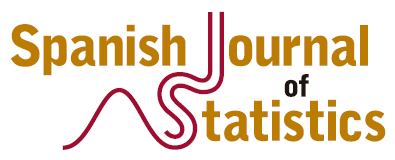Author guidelines
- Submissions
- Manuscript Preparation
- Title Page that includes the paper's title; affiliations and email addresses of all co-authors; for the corresponding author, also the telephone number with country code should be included. Please make sure this information is up to date.
- Abstract of the paper should be in the Manuscript file that you upload preceding the manuscript text. Abstract should be a maximum of 250 words.
- Keywords arranged in alphabetical order in the same page of the abstract.
- Up to four Mathematics Subject Classification (MSC) codes should be provided.
- All figures and tables include a brief, clear, self-explanatory title. Ensure all figure and table citations in the text are correct.
- Only the references cited in the text are mentioned in the Reference List.
- Referee suggestions with contact details.
- In the text, only the authors' surnames should be given, followed by
the year of publication in parentheses. For three or more authors, only the
first surname should be given, followed by et al. Some examples:
- (Fine et al. 1999);
- Kaplan and Meier(1958);
- (Aamport 1986a, b; Ward 1963, 1970)
- The references should be listed in alphabetical order of surnames at the end of the text in the section named “References”.
- Peer Review Process
- Open Access Policy
- Ethics and best practices
- Copyright Notice
- Privacy Statement
The Spanish Journal of Statistics publishes original papers in the theory and applications of statistics. A PDF electronic version of the manuscript should be submitted to José María Sarabia, Editor in chief of SJS via email to sjs@ine.es. Submissions will only be considered in English.
Manuscripts must be original contributions which are not under consideration for publication anywhere else. Its contents have been approved by all authors and. A single-blind refereeing system is used, so the identity of the referees is not communicated to the authors. Manuscripts that exceed 30 journal pages are unlikely to be considered for publication. .
We differentiate between the requirements for new and revised submissions. Manuscripts should be submitted as a single PDF file to be used in the refereeing process. You will be requested to put your paper in to a 'correct format' for acceptance only when your paper is at the revision stage.
New submissions
Please, ensure that your submission includes the following items:
Revised submissions
Manuscripts should be submitted in LaTeX. We provide a LaTex template for submissions. The folder includes sjs.cls, sjs_style.sty, SJS_template.tex, and SJS_template.pdf. Use SJS_template.tex as a template for the preparation of your manuscript. Your submission should include both the original source named as “main_manuscript.tex”, all style files and figures and a PDF version of the compiled output also named as “main_manuscript.pdf”.
Please use the decimal system of headings, but with no more than three levels. Abbreviations should be defined at first mention. Footnotes to the text are numbered consecutively and used to provide additional information. Even though they may include the citation of a reference included in the reference list, they should not consist of a reference citation. Footnotes should not contain figures or tables. Footnotes to tables should be indicated by superscript lower-case letters. Please do not use endnotes, always footnotes.
Acknowledgments should be placed in a separate section before the References. The names of funding organizations should be written in full. It is recommended to use the following format:
Acknowledgements: This work was supported by the FUNDING SOURCE [grant number XXX]; FUNDING SOURCE [grant number YYY]; and FUNDING SOURCE [grant number ZZZ]
Please, use the standard mathematical notation for formulae: italic for single letters that denote mathematical constants, variables, and unknown quantities; roman/upright for numerals, operators, and punctuation, and commonly defined functions or abbreviations, e.g., cos, det, lim, log, max, min, sin, tan; and bold for vectors, tensors, and matrices.
References should not be numbered but standardised as follows:
Examples of a paper in a journal, a book, a book chapter, conference proceedings and statistical software:
Kaplan, E. L., and Meier, P. (1958). Nonparametric estimation from incomplete observations. Journal of the American Statistical Association, 53(282):457–481.
Wellek, S. (2003). Testing Statistical Hypotheses of Equivalence. Chapman & Hall/CRC Press, New York.
Lincoll, D. D. (1977). Semigroups of recurrences. In Lipcoll, D. J., Lawrie, D. H., and Sameh, A. H., editors, High Speed Computer and Algorithm Organization, number 23 in Fast Computers, part 3, pages 179–183. Academic Press, New York, third edition.
Oaho, A. V., Ullman, J. D., and Yannakakis, M. (1983). On notions of information transfer in VLSI circuits. In Oz, W. V. and Yannakakis, M., editors, Proc. Fifteenth Annual ACM Symposium on the Theory of Computing, number 17 in All ACM Conferences, pages 133–139, Boston. The OX Association for Computing Machinery, Academic Press.
H. Wickham. (2016). ggplot2: Elegant Graphics for Data Analysis. https://ggplot2.tidyverse.org
Manuscripts not adhering to journal guidelines will be returned to authors without scientific evaluation. All manuscripts submitted for publication in our journals are peer-reviewed. The Editorial Office will examine all submissions to avoid potential plagiarism issues. Once the Editorial Office inspects it and verifies that your submission and associated file are original and complete, the editor will decide if the manuscript is suitable for publication in SJS. If so, the Editor the editor will ask experts in the field to write a referee report. The Editors final decision is sent to the Corresponding Author.
All articles are distributed under the terms of the Creative Commons Attribution License, CC BY (or the Creative Commons Attribution-NonCommercial License CC BY-NC), which allows users to (noncommercially) copy, use, distribute, transmit and display the work publicly and to make and distribute derivative works, in any digital medium for any responsible purpose, subject to proper attribution of authorship.
The use of general descriptive names, trade names, trademarks, and so forth in this publication, even if not specifically identified, does not imply that these names are not protected by the relevant laws and regulations.
While the advice and information in this journal are believed to be true and accurate on the date of its publication, neither the authors, the editors, nor the publisher can accept any legal responsibility for any errors or omissions that may be made. The publisher makes no warranty, express or implied, about the material contained herein.
INE Spain is committed to maintaining high standards through a rigorous peer-review together with strict ethical policies. Any infringements of professional ethical codes, such as plagiarism, fraudulent use of data, bogus claims of authorship, should be taken very seriously by the editors with zero tolerance.
INE follows the Code of Conduct of the Committee on Publication Ethics (COPE), and follows the COPE Flowcharts for Resolving Cases of Suspected Misconduct.
Authors will be asked, upon acceptance of an article, to transfer copyright of the articles to the Spanish Institute of Statistics. This entails full copyright protection and wide dissemination of the articles and the journal in any format
To achieve the purpose of this publication, INE needs to process personal data. In all these processing operations, the INE acts in accordance with current legislation on the protection of personal data.




